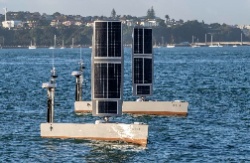Using Ocean Temperature Differences for Renewable Energy
Ocean Thermal Energy Conversion (OTEC) is an idea for
creating renewable energy by exploiting the difference in
ocean temperatures between the surface and the seabed. The
OTEC permit office first opened in 1981 as part of NOAA,
America's National Oceanic and Atmospheric Administration,
the marine counterpart to NASA. It was created after the oil
price spike of the 1970's when interest in alternative power
sources rose. Oil prices eventually settled and as a result
interest in the alternative power sources dwindled, so in
1994, just 13 years later the OTEC office was closed without
ever having issued a permit. Good old American
bureaucracy.
Now, again during times of high oil prices, alternative energy sources are back with vengeance. All options are being considered and one of them is OTEC. Luckily the concept is reasonably simple. A fluid with a low boiling point, such as ammonium, is vaporised in a heat exchanger using surface water from the sea with an average temperature of about 25°C. The resulting gas has a sufficient pressure to drive a turbine and create electricity. The gas is then cooled using seawater pumped up from a depth of about one kilometre and with an average temperature of about 5°C. The liquid ammonia can then be reheated and the whole process started again. Theoretically this means that OTEC plants can be built anywhere with a surface water temperature of 25°C and a depth of at least one kilometre.
One company pursuing OTEC technology is Lockhead Martin, which is collaborating with a smaller firm called Makai Ocean Engineering to build a 10 megawatt plant in Hawaii that is projected to open in 2015. Then if this plant is successful the idea is to construct a 100 megawatt plant by 2020.
Most of the technology necessary can be taken from existing areas of engineering, such as deepwater oil drilling, where the heat exchangers and pipework required to make a 10MW plant already exist. The 100MW facility however will need a pipe that is not only 1km long but also ten metres in diameter, in order to supply the necessary amount of water. It must also be strong enough to resist waves and ocean climates for decades. Kerry Kehoe, the current head of OTEC activities at NOAA, estimates such a facility could cost $1 billion.
By. James Burgess of Oilprice.com
Source: http://oilprice.com/Alternative-Energy/Renewable-Energy/Using-Ocean-Temperature-Differences-to-Create-Renewable-Energy.html
ENDS


 NZ Harkness Fellowship Trust: Championing Innovation In Māori Economic Development - Jacob (Hākopa) Ashdown Named 2025 Harkness Fellow
NZ Harkness Fellowship Trust: Championing Innovation In Māori Economic Development - Jacob (Hākopa) Ashdown Named 2025 Harkness Fellow ICHRP: Trump 20% Tariff On Philippine Exports Hits Workers, Farmers Hardest
ICHRP: Trump 20% Tariff On Philippine Exports Hits Workers, Farmers Hardest New Zealand Defence Force: HMNZS Canterbury Delivers Leading-Edge Technology To Support Regional Security Tasks In Fiji
New Zealand Defence Force: HMNZS Canterbury Delivers Leading-Edge Technology To Support Regional Security Tasks In Fiji Asia New Zealand Foundation: ASEAN Young Business Leaders To Meet In Viet Nam, Marking 50 Years Of ASEAN-New Zealand Relations
Asia New Zealand Foundation: ASEAN Young Business Leaders To Meet In Viet Nam, Marking 50 Years Of ASEAN-New Zealand Relations Asian Human Rights Commission: Nepal | Joint Submission To The UN Universal Periodic Review - 51st Session Of The UPR Working Group
Asian Human Rights Commission: Nepal | Joint Submission To The UN Universal Periodic Review - 51st Session Of The UPR Working Group Caleb Fotheringham, RNZ Pacific: Cook Islands' 60th Anniversary - 'Who New Zealand Sends, Sends A Message'
Caleb Fotheringham, RNZ Pacific: Cook Islands' 60th Anniversary - 'Who New Zealand Sends, Sends A Message'